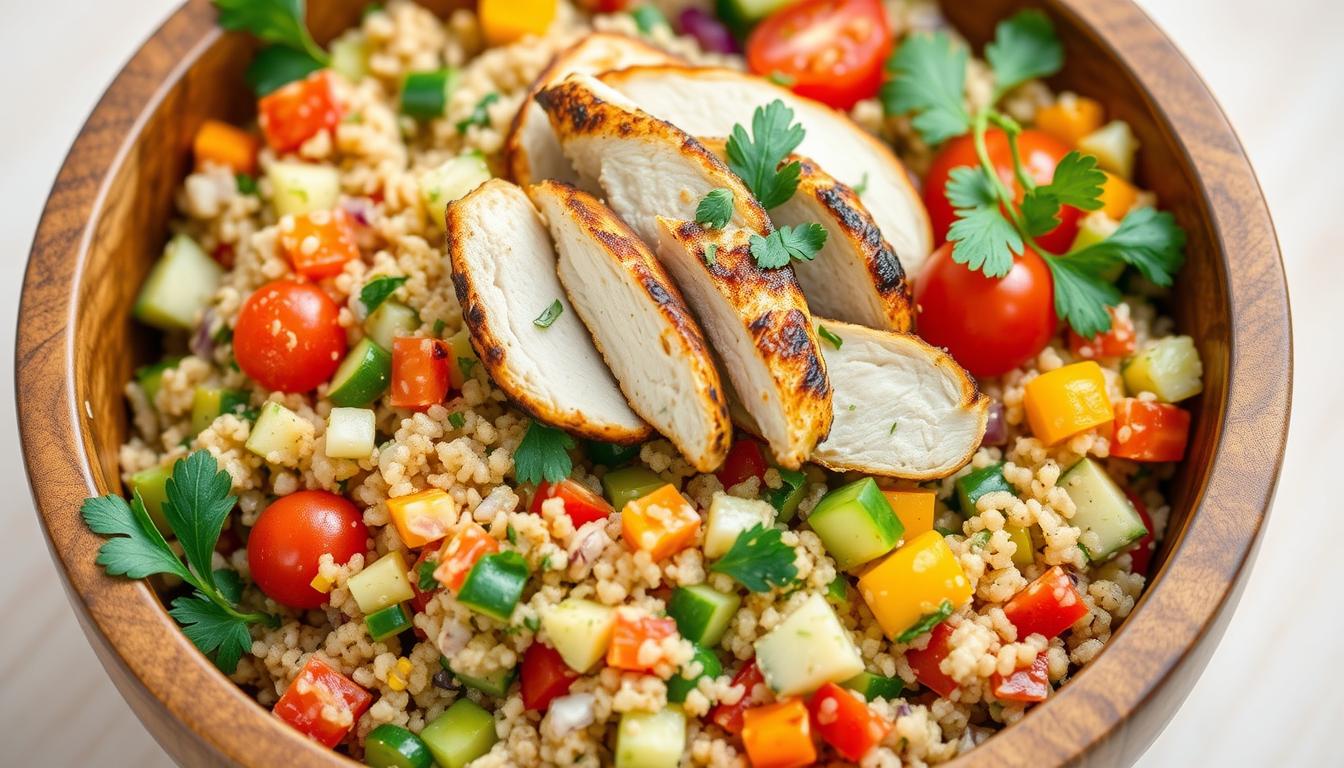Are you tired of the same old salads for managing endometriosis symptoms? Our endo-friendly quinoa chicken salad is here. It’s not just tasty, but also packed with nutrients to help ease your pain and boost your health. Did you know endometriosis affects about one in ten women during their reproductive years? It often takes seven years to get a diagnosis.
It’s time to take charge of your health with this anti-inflammatory recipe. Start enjoying a better life today.
Unleash the Power of Quinoa: A Nutritious Endo-Friendly Grain
Quinoa is a remarkable grain that offers numerous benefits for individuals with endometriosis. It is gluten-free, nutrient-dense, and low in FODMAPs. This makes it an excellent choice for those following an endometriosis-friendly diet.
Gluten-Free, Nutrient-Dense, and Low in FODMAPs
Quinoa is rich in fiber, protein, and essential vitamins and minerals. It is a valuable addition to any meal. It is gluten-free, low in FODMAPs, and packed with nutrients that can help manage the condition.
Quinoa’s Role in Managing Endometriosis Symptoms
Research suggests that quinoa may play a role in managing endometriosis symptoms. Its anti-inflammatory properties and ability to support gut health can be beneficial. This can help alleviate pain and discomfort associated with the condition.
By incorporating quinoa into your diet, you can harness the power of this nutrient-dense grain. It supports your overall well-being and helps manage the symptoms of endometriosis.
Endo friendly quinoa chicken salad: A Flavorful Anti-Inflammatory Delight
Meet our anti-inflammatory quinoa chicken salad, a tasty and healthy choice for those with endometriosis. It’s made with quinoa, a gluten-free grain, and other nutrients that help your body feel good.
Quinoa is the main ingredient in this flavorful quinoa dish. It’s full of protein and vitamins, making it great for a healthy meal. We mix it with quinoa chicken for a dish that’s both filling and good for you.
| Ingredient | Benefits |
|---|---|
| Quinoa | Gluten-free, high in protein, and low in FODMAPs |
| Grilled Chicken Breast | Lean protein to support muscle recovery and endometriosis management |
| Avocado | Rich in healthy fats and anti-inflammatory properties |
| Cherry Tomatoes | Packed with antioxidants and vitamins to support overall health |
| Arugula | Leafy green with anti-inflammatory benefits |
This flavorful quinoa chicken recipe is not just tasty but also good for you. It’s made to help with endometriosis symptoms and is a joy to eat.
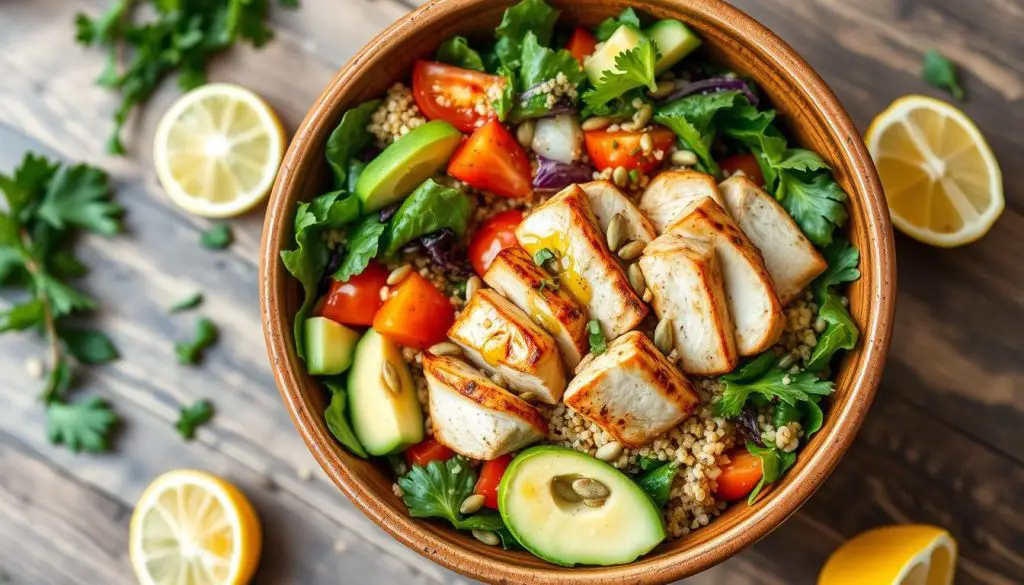
Try our anti-inflammatory quinoa chicken salad for a taste adventure. It’s a step towards a healthier, happier life, one delicious bite at a time.
The Benefits of a Low FODMAP Diet for Endometriosis
For those with endometriosis, a low-FODMAP diet can be very helpful. FODMAPs are carbs that can cause digestive problems and inflammation. By eating low-FODMAP foods, you can manage your symptoms and feel better overall.
Understanding FODMAPs and Their Impact on Endo
FODMAPs make endometriosis symptoms worse, like bloating and pain. Eating fewer high-FODMAP foods and more low-FODMAP ones can help. This diet change can greatly improve your life with endometriosis.
Low FODMAP Foods to Incorporate into Your Diet
- Quinoa
- Gluten-free grains (such as rice, oats, and buckwheat)
- Lean proteins (like chicken, turkey, and seafood)
- Non-starchy vegetables (such as spinach, kale, and broccoli)
- Low-lactose dairy products (like lactose-free milk and hard cheeses)
- Berries and citrus fruits
- Nuts and seeds (in moderation)
Eating these low-FODMAP foods can reduce inflammation and discomfort. It’s important to work with a dietitian to find the right foods for you. This way, you can get the most benefits from a low-FODMAP diet.
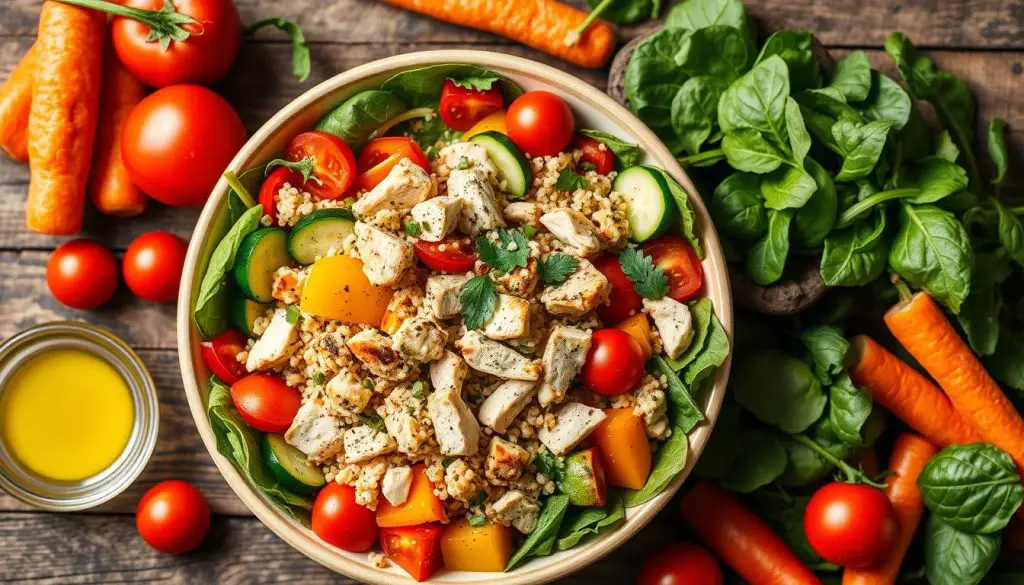
High-Protein Quinoa Chicken: Fuel Your Body Right
Managing endometriosis means eating foods rich in nutrients. Our high-protein quinoa chicken salad is perfect. Quinoa is a complete protein, packed with essential amino acids. It’s paired with lean chicken, making it a powerhouse of endometriosis-friendly nutrients to fuel your body.
Quinoa does more than just provide protein. It’s also a low FODMAP food, ideal for those with endometriosis. It helps reduce inflammation and eases discomfort.
This dish is great for nourishing your body and managing endometriosis symptoms. Enjoy the high protein quinoa chicken salad as a tasty and fulfilling meal. You’ll know you’re giving your body the right nutrients.
| Nutrient | Quinoa (100g) | Chicken Breast (100g) |
|---|---|---|
| Protein | 4.4g | 31g |
| Carbohydrates | 21g | 0g |
| Fats | 1.9g | 3.6g |
Adding this quinoa chicken for endometriosis dish to your diet ensures your body gets the high protein nourishment it needs. It helps manage your endometriosis symptoms effectively.
Gut Health and Endometriosis: The Vital Connection
Recent studies have highlighted the important link between gut health and endometriosis. A balanced gut microbiome can help manage endometriosis symptoms. It does this by reducing inflammation, boosting the immune system, and controlling hormone levels. The quinoa chicken salad in this article includes ingredients that support a healthy gut, aiding in endometriosis management.
How a Healthy Gut Supports Endometriosis Management
Research shows that people with endometriosis often have an unbalanced gut microbiome. This imbalance can worsen endometriosis symptoms. By focusing on gut health endometriosis, we can tackle the gut-related issues that make symptoms worse.
- Reducing inflammation: A healthy gut microbiome can lower inflammation, which is a major cause of endometriosis pain.
- Boosting immune function: A balanced gut helps the immune system work better, which is key for managing endometriosis.
- Regulating hormone levels: The gut influences hormone metabolism and regulation, affecting endometriosis-related hormonal imbalances.
By incorporating gut-friendly foods and practices, people with endometriosis can improve their gut health. This can help manage symptoms more effectively.
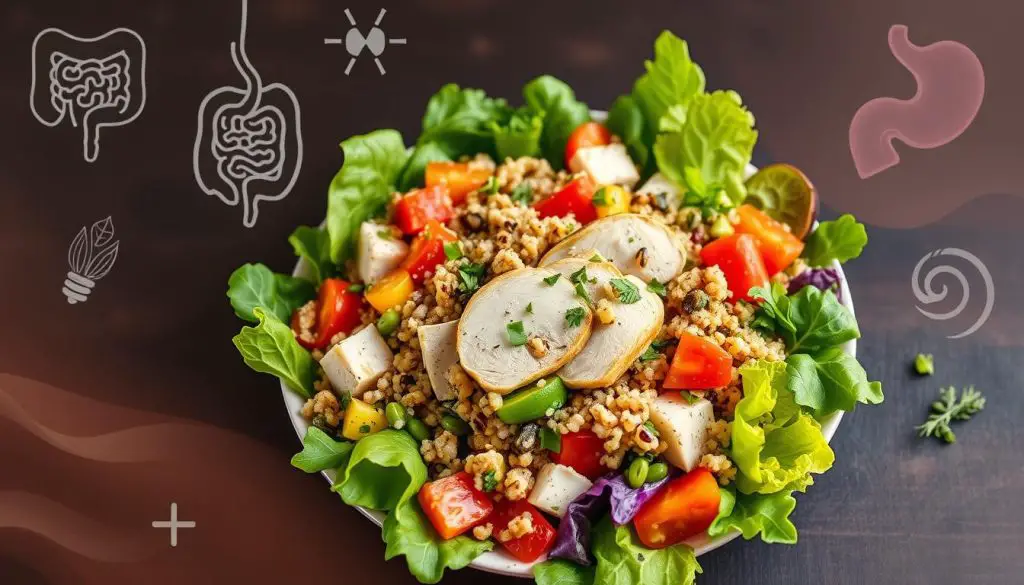
The endometriosis gut microbiome connection is a growing area of research. Studies are finding that gut health is critical for managing this complex condition. By making smart dietary and lifestyle choices, individuals with endometriosis can improve their overall health and possibly reduce symptoms.
Clean Eating Lunch Option: Nutritious and Delicious
Goodbye to boring lunches and hello to our clean eating quinoa chicken salad! This meal is both nourishing and delicious endo friendly. It’s the ideal choice for your midday meal. We’ve made it with wholesome, unprocessed ingredients and avoided common endometriosis triggers.
The salad starts with fluffy quinoa, a gluten-free, nutrient-rich grain that’s low in FODMAPs. It’s paired with tender, flavorful chicken for a protein boost. Cherry tomatoes and cucumbers add vibrant color and refreshing textures. Creamy avocado and tangy garlic yogurt sauce bring everything together in a delicious mix.
This clean eating quinoa chicken salad is perfect for meal prep or a quick lunch. It’s packed with anti-inflammatory properties and endometriosis-friendly ingredients. It’s a tasty way to nourish your body and support your health.
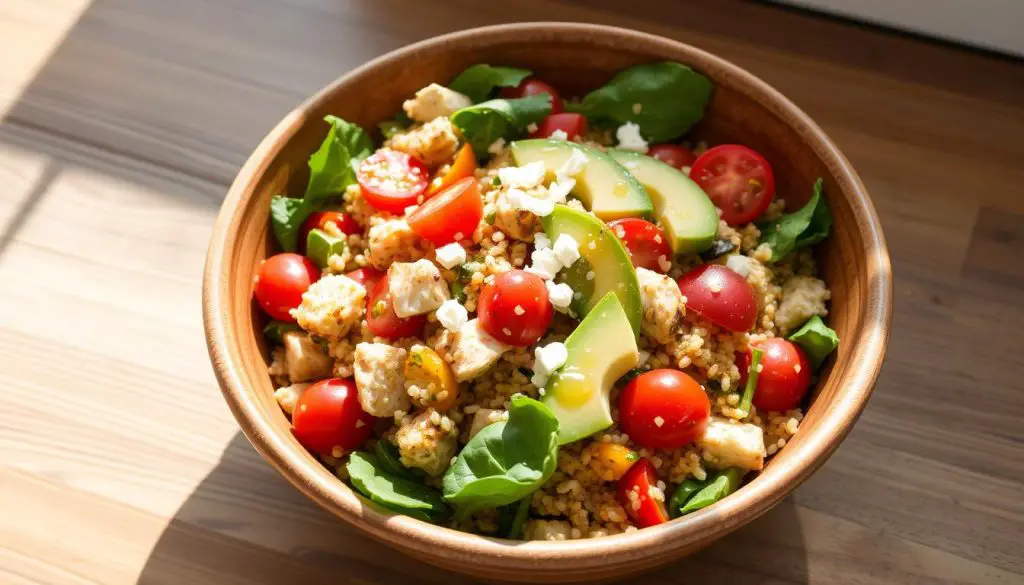
Try the power of clean eating with this nutritious and delicious quinoa chicken salad. It’s a win-win for lunchtime, leaving you feeling full and energized for the rest of your day.
Hormone-Friendly Cuisine: Nourishing Your Body Holistically
Our quinoa chicken salad is not just good for endometriosis. It also helps balance hormones. Ingredients like quinoa and anti-inflammatory spices help control hormone levels. This reduces the effects of hormonal changes on endometriosis symptoms.
By choosing foods that balance hormones, we nourish our bodies. This supports our overall health while managing endometriosis.
Adapting Recipes for Hormonal Balance
Keeping hormones in balance is key for managing endometriosis. During the luteal phase, appetite increases by 200-300 calories a day. Eating foods that support progesterone can help with PMS, energy, and digestion.
Our quinoa chicken salad is made with these goals in mind. It has fiber, B vitamins, complex carbs, calcium, magnesium, healthy fats, and omega-3s.
- Quinoa is a hormone-friendly grain that contains all nine essential amino acids. It helps regulate blood sugar and balance hormones naturally.
- Eggs are a high-protein food that helps keep insulin and ghrelin levels balanced for hormonal balance.
- Leafy greens like spinach and kale increase testosterone levels in women’s bodies.
- Salmon, sardines, and other fatty fish promote hormonal balance with omega-3 fatty acids.
- Avocado stabilizes glucose levels and lowers cholesterol, contributing to hormonal balance.
- Chicken breast is essential for hormone balance and overall health.
By using these hormone-friendly ingredients, we make recipes that nourish our bodies. They support our journey with endometriosis.
Anti-Inflammatory Ingredients: Nature’s Allies
Our quinoa chicken salad is packed with anti-inflammatory ingredients to help with endometriosis symptoms. Quinoa, the main ingredient, is a gluten-free and nutrient-dense superfood. It supports your body’s healing.
We’ve added leafy greens like spinach and kale, full of antioxidants and anti-inflammatory compounds. The salad also has turmeric and ginger, known for their strong anti-inflammatory effects. These ingredients work together to fight inflammation and nourish your body.
| Anti-Inflammatory Ingredients | Benefits |
|---|---|
| Quinoa | Gluten-free, nutrient-dense, and low in FODMAPs, quinoa is a great choice for managing endometriosis symptoms. |
| Leafy Greens (Spinach, Kale) | Rich in antioxidants and anti-inflammatory compounds, leafy greens can help reduce inflammation in the body. |
| Turmeric | A powerful spice with potent anti-inflammatory properties, turmeric can help alleviate endometriosis-related pain and discomfort. |
| Ginger | Known for its anti-inflammatory effects, ginger can also aid in digestive function and provide relief from menstrual cramps. |
By adding these natural anti-inflammatory ingredients to your anti inflammatory quinoa chicken salad, you’re taking a step towards managing endometriosis symptoms. Embrace the power of endometriosis anti-inflammatory foods and let nature’s allies help you.
Step-by-Step Guide to Preparing the Perfect Quinoa Chicken Salad
Get ready to make a delicious quinoa chicken salad! It’s full of nutrients and easy to make. Follow these steps to make the perfect salad.
Ingredient Checklist and Preparation Tips
First, gather all the ingredients:
- 2 cups cooked quinoa (about 2/3 cup uncooked)
- 1.5 cups cooked and shredded chicken breast
- 1 cup cherry tomatoes, halved
- 1 cup Persian cucumbers, diced
- 1/2 cup avocado, diced
- 1/4 cup fresh mint and/or parsley leaves, chopped
- 1 tablespoon Aleppo pepper (or chili powder)
- Garlic yogurt sauce (1 cup Greek yogurt, 2 cloves garlic, 2 tablespoons olive oil, 1 tablespoon lemon juice)
- 1.5 cups smoky roasted chickpeas
To make sure your quinoa is fluffy and chicken tender, follow these tips:
- Cook the quinoa as package instructions say, simmer for 15 minutes, then stand for 10 minutes off heat.
- Roast the chickpeas in the oven at 425°F for 20-30 minutes until crispy and golden brown.
- Grill or bake the chicken breasts until fully cooked through and shred them into bite-sized pieces.
Cooking Instructions for Tender, Flavorful Chicken
To cook chicken perfectly and full of flavor, follow these steps:
- Preheat your grill or oven to 400°F (200°C).
- Season the chicken breasts with salt, pepper, and any other desired spices.
- If grilling, cook the chicken for 6-8 minutes per side, or until the internal temperature reaches 165°F (75°C).
- If baking, place the chicken in a baking dish and roast for 20-25 minutes, flipping halfway, until the internal temperature reaches 165°F (75°C).
- Allow the cooked chicken to rest for 5-10 minutes before shredding or slicing it into bite-sized pieces.
Now that you have the quinoa, chicken, and chickpeas ready, it’s time to make the quinoa chicken salad. Mix all the ingredients in a large bowl. Drizzle with the creamy garlic yogurt sauce. Enjoy this tasty, anti-inflammatory salad!
Customizing Your Quinoa Chicken Salad: Endless Possibilities
The quinoa chicken salad is not just one dish. It’s a blank canvas for your creativity. You can make it fit your taste and dietary needs. Adding different ingredients can turn it into a meal that’s just right for you.
Tasty Add-Ins and Topping Suggestions
Think about your favorite herbs. Basil, cilantro, or parsley can make your salad taste amazing. For a crunchy texture, try toasted nuts like slivered almonds or chopped walnuts.
For a sweet twist, add dried cranberries, apples, or grapes. For a tangy flavor, use lemon or lime juice, balsamic vinegar, or a homemade vinaigrette. Use healthy fats like olive oil or avocado oil for the dressing.
Feel free to mix and match ingredients. This quinoa chicken salad is perfect for anyone. It’s great for any meal because you can customize it to your liking.
Meal Prep and Storage Tips: Enjoy Leftovers with Ease
Meal prep is key for our quinoa chicken salad. It makes this endometriosis-friendly dish easy to enjoy all week. Here are some tips to make leftovers a breeze.
First, storing leftovers right is important. Our quinoa chicken salad stays fresh in the fridge for up to 4 days. Just divide it into portions in airtight containers. This way, you have a healthy meal ready whenever you want. 70% of food waste in homes is avoidable, so meal prep helps save money and reduce waste.
Reheating leftovers is easy and keeps the salad delicious. Just microwave it for a minute or warm it on the stovetop. The quinoa, chicken, and veggies stay tasty and fresh. You can also get creative with leftovers, like in a quinoa burrito bowl or as a base for another meal. The options are endless!
Source Links
- https://sofreshnsogreen.com/recipes/endometriosis-diet-recipes/
- https://www.favfamilyrecipes.com/endorian-roasted-chicken-salad/
- https://floliving.com/blog-categories/endometriosis
- https://www.primeivfcentre.com/blog/best-foods-increase-fertility
- https://joythebaker.com/2019/03/six-weekday-meals-im-eating-right-now/
- https://www.endo-gym.com/food
- https://www.ssmhealth.com/SSMHealth/media/Documents/slucare/services/obstetrics-gynecology-womens-health/endometriosis-diet-booklet.pdf
- https://www.verywellhealth.com/endometriosis-diet-7105372
- https://www.businessinsider.com/guides/health/conditions-symptoms/endometriosis-diet
- https://www.wellandbalancedlife.com/fat-protein-efficient-diet-for-moms/
- https://www.lemon8-app.com/hannahosmon/7241326510169473542?region=us
- https://supremerestaurant.nyc/meal-plans-for-fitness/
- https://healthunlocked.com/endometriosis-uk/posts/142528506/no-more-pain-with-keto-diet-the-healthy-endo-friendly-version-gluten-dairy-red-meat-free
- https://www.usenourish.com/blog/high-protein-lunch
- https://www.signos.com/blog/mediterranean-diet-lunch-ideas
- https://www.theroastedroot.net/kale-quinoa-salad/
- https://sofreshnsogreen.com/recipes/luteal-phase-foods/
- http://www.healingcedarwellness.com/blog/archives/11-2013
- https://www.psfc.in/8-foods-that-help-with-hormonal-balance/
- https://www.everydayhealth.com/diet-and-nutrition/diet/whole30-program-what-know-before-starting-diet-plan/
- https://njacucenter.com/wp-content/uploads/2019/10/Fertility-Diet-New.pdf
- https://eatburnsleep.com/tag/gut-bacteria/
- https://www.drlamcoaching.com/blog/quinoa-salad/
- https://www.loveandlemons.com/quinoa-bowl/
- https://realfoodwholelife.com/recipes/slow-cooker-greek-chicken/
- https://floliving.com/blog?49d1e480_page=17
- https://www.linkedin.com/posts/getnourishedwitharia_are-you-a-meal-prepper-as-a-busy-mom-one-activity-7206294115976708096-wl-y
- https://www.tasteofhome.com/article/14-day-meal-plan/
